

Cabbage moth (Pieris brassicae) is a large white butterfly species. It uses cabbage leaves as food for caterpillars of the next generation. Wings are white with black spots on them.
Cabbage moth can completely destroy a harvest in the vegetable patch.
Read also:
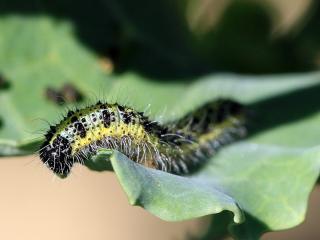
Take a closer look: you might find a hairy caterpillar… or a hundred!
This pest seeks most types of Brassica plants. It prefers all kinds of cabbage species, but you’ll find it on occasion on other host plants, too. For example, it loves nasturtium and, as in the picture at top, lavender.
In the United States, this caterpillar is called large white.
In the United Kingdom it goes by the name cabbage white or cabbage moth.
Actually, it isn’t a moth at all, but a type of butterfly!
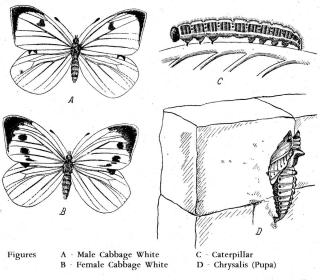
The white butterflies flutter to the undersides of cabbage leaves to lay eggs there. Once they hatch, tiny caterpillars start colonizing the plants, damaging them as they feed. Indeed, these caterpillars find cabbage leaves particularly appealing! Holes appear on the cabbage leaves.
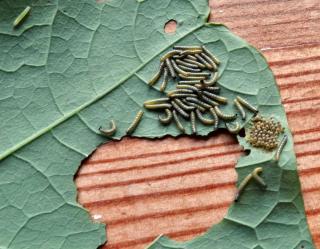
How is this possible?
Simple math: 3 generations can fit during a normal growing season:
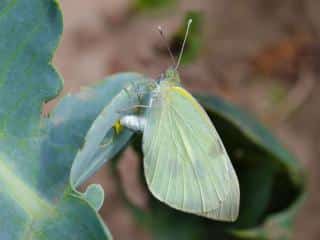
The cousin of Pieris brassicae, Pieris rapae, has an opposite strategy: a single egg per plant. That way, even measly, scraggly plants can also serve as host plants.
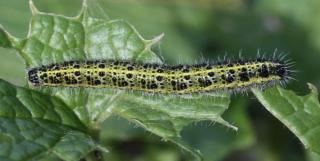
That’s why it’s better to work on preventive measures, since you’ll have less work and damage later on.
There are quite a few organic cabbage moth treatments. It’s perfectly possible to treat against Pieris brassicae without using a single drop of toxic products.
Firstly, it’s common to try to protect your cabbage against this moth with a protective net. This is a solution that is only effective if you’re certain that no hibernating larvae are hiding, dormant, in the soil. If there were, a net wouldn’t help at all, since they’d already be inside!
Many plants repel cabbage moth: absinthe, lemon balm, mint, cosmos, sage, tomato, and also thyme herb, too. Planting these is really the best way to increase biodiversity in the garden, which, as a side effect, also helps produce different crops simultaneously!
You might be familiar with nasturtium. They’re often used as a decoy that attracts aphids. It’s the opposite of a repellent: it attracts pests away from other plants! This also works with cabbage moth: caterpillars will feast on nasturtium instead of cabbage.
As soon as you notice them, slice and scrape any eggs off the leaves with a knife. This certainly is a heavy chore if the infestation is severe, but it’s the only way to guarantee 100% healthy cabbages.
If ever caterpillars have started seriously damaging your heads of cabbage, the only option left is to spray them with Bacillus thuringiensis, which is an organic insecticide available in every garden store. Spray the product about 8 inches (20 cm) from the leaves, and spray again, if needed, a few days later.
Other natural options are also possible. We strongly recommend a decoction prepared from chamomile, tansy, wormwood and common vervain.
Read also:
Large white, as an adult, feeds on a great many types of flowers.
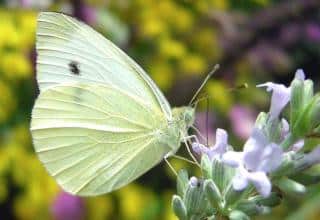
For laying eggs, though, fewer plant species serve as hosts for this cabbage caterpillar – but these include a great many veggies! Sometimes the female will lay on the “wrong” plant, and the caterpillars will need to reach a new plant. Indeed, sometimes specific nutrients are missing that make it impossible for the caterpillar to transform into the adult butterfly form.
Buddleia (also known as butterfly bush), Nasturtium, Arabis, ornamental tobacco, wallflower (the European species)…
Brassica (cabbage, rutabaga or swede, mizuna, broccoli, milan cabbage, Brussels sprouts, cauliflower…), sea kale (Crambe maritima), certain Allium like garlic and onion, radish, turnip, arugula, watercress…
Practice companion planting: in particular, pairing cabbage with both celery and tomato plants will repel cabbage moth.